Projected Changes in Extreme Precipitation Patterns across Algerian Sub-Regions
Abstract
:1. Introduction
2. Study Area
- The Csa climatic zone, characterized by a hot-summer Mediterranean climate, is represented by Zones 1 and 2.
- The BSk/BSh climatic zone, representing the cold/hot semi-arid climate zone, which is covered by Zones 3 and 4.
- The BWk/BWh climatic zone, indicating the cold/hot desert climate in Zone 5.
3. Materials and Methods
3.1. Data
3.2. Methods
- After calculating the four ETCCDI extreme precipitation indices for the historical period (1990–2014) as well as for the three future periods ((2026–2050), (2051–2075), and (2076–2100)) under both SSP245 and SSP585 scenarios, the average of each ETCCDI index was calculated for each grid cell over the four periods. Then, the changes between the three future periods were determined and compared to the historical period using relative change (%) for the indices PRCPTOT (mm), RX1day (mm), RX5day (mm), R95p (mm), and R99p (mm), and absolute change (days) for the two indices R10mm (days) and R20mm (days). The relative change (%) and absolute change (days) between the ETCCDI indices were calculated at each grid cell level over the historical period () and the projected periods (), according to the following expressions.
- For each of the five defined zones and each of the ETCCDI extreme precipitation indices, the mean relative change (%) and the mean absolute change (in days) were calculated for each zone for each climate model, as well as the ensemble mean of all models (MME-33) for the three future periods ((2026–2050), (2051–2075), and (2076–2100)) under both SSP245 and SSP585 scenarios.
- After calculating the mean relative (%) and absolute (in days) changes in each index for each zone and climate model over three future periods according to the SSP245 and SSP585 scenarios, the relative changes in the 33 climate models are presented in each zone for the three future periods under the two scenarios using box and whisker plots. Each box represents the distribution of model relative changes for a specific period and for each zone with both scenarios. In these box and whisker plots, the medians, quartiles, and inter-quartile ranges are clearly visible, enabling a quick comparison of projected variations by different models in each zone and with the two scenarios. Additionally, spatial maps of each model for the four indices and their changes over the three future periods are provided under the two scenarios.
- After calculating the mean relative (%) and absolute (in days) changes for each zone and climate model over three future periods according to the SSP245 and SSP585 scenarios, the number of models out of the 33 was assessed for indications of an increase or decrease in the extreme precipitation index. An increase or decrease is considered significant if it is simulated in at least 22 models, which is two-thirds of the total models (33 models) or 66% of the models [21].
- For each extreme precipitation index from the ETCCDI for each climate model, specific grid cells were defined for each zone and plotted in the form of the kernel density distribution (KDD) for the historical period (1990–2014) as well as for the three future periods ((2026–2050), (2051–2075), and (2076–2100)) according to the SSP245 and SSP585 scenarios. This analysis was performed by identifying specific grid cells for each zone from the ensemble of models simultaneously. The kernel density distribution (KDD) [26] is a non-parametric approach used to estimate the probability distribution function (PDF) of data based on their density without assuming a specific PDF shape. It relies on the use of kernels, typically PDFs such as the Gaussian, to estimate the probability density at each data point. The KDD is widely used in data analysis and is available in the Python seaborn library under the sns.kdeplot() module. The bandwidth, a key parameter of the method, controls the width of the window around each point from which estimation data are considered. A wider bandwidth produces a smoother estimate but may lose details, while a narrower bandwidth can capture local variations under more noise. Jones [26] studied the performance of kernel density functions, while Kamalov [27] demonstrated the applicability of KDD in various contexts. In this study, a bandwidth of 0.1 was used, which smoothed the data over a window of 0.1 units to balance smoothing and to capture local variations.
4. Results
4.1. Future Evolution of Extreme Precipitation Indices in Each Zone
4.1.1. Relative Changes (%) in Indices for Each Model Simulation
- a.
- Annual Total Precipitation in Wet Days (PRCPTOT)
- b.
- Annual maximum 1-day precipitation (RX1day)
- c.
- Annual total precipitation from days > 99th percentile (R99p)
- d.
- Number of heavy precipitation days (R20mm)
4.1.2. Relative Percentage Variations in Indices for Each Zone by All Models
- a.
- Annual Total Precipitation in Wet Days (PRCPTOT)
- b.
- Annual maximum 1-day precipitation (RX1day)
- c.
- Annual total precipitation from days > 99th percentile (R99p)
- d.
- Number of heavy precipitation days (R20mm)
4.2. Analysis of the Significance of Changes in Extreme Precipitation Indices: Analysis of Model Consensus
- a.
- Annual Total Precipitation in Wet Days (PRCPTOT)
- b.
- Annual maximum 1-day precipitation (RX1day)
- c.
- Annual total precipitation from days > 99th percentile (R99p)
- d.
- Number of heavy precipitation days (R20mm)
4.3. Kernel Density Distribution (KDD) Plots for Extreme Precipitation Indices across Studied Periods and Regions Using MME-33
- a.
- Annual Total Precipitation in Wet Days (PRCPTOT)
- b.
- Annual maximum 1-day precipitation (RX1day)
- c.
- Annual total precipitation from days > 99th percentile (R99p)
- d.
- Number of heavy precipitation days (R20mm)
5. Discussion and Conclusions
- Despite the differences among the individual models, the multi-model ensemble MME-33 predicted a decrease in annual precipitation in Zones 1 (eastern coastal), 2 (between the eastern coastal zone and the High Plateaus), 3 (western coastal regions), and 4 (High Plateaus) and an increase in Zone 5 (desert regions). The rate of increase or decrease projected by all 33 models for the SSP585 scenario was higher than the one projected for the SSP245 scenario. Furthermore, this rate of change gradually increased from the period of 2026–2050 to the period of 2076–2100. The MME-33 ensemble showed a decreasing trend in precipitation in Zones 1, 2, 3, and 4 for the period of 2026–2050 with percentages that ranged from 7.5% to 8.5% under the SSP245 scenario and 7.5% in Zones 1 and 2; 8.5% in Zone 3; 7.7% in Zone 4 under the SSP585 scenario. This trend intensified over time, with percentage decreases reaching up to 15% in Zone 1, 14.3% in Zone 3, and 16.1% in Zone 4 for the period of 2076–2100 under the SSP245 scenario, and 15.1% in Zone 1, 14.3% in Zone 3, and 16.1% in Zone 4 for the period of 2076–2100 under the SSP585 scenario. Conversely, under the SSP245 scenario, the increases in precipitation in Zone 5 were, respectively, 8.01%, 4.04%, and 3.31% for the periods of 2026–2050, 2051–2075, and 2076–2100. Under the SSP585 scenario, these increases were 8.1%, 4.1%, and 3.5% for the same periods. The average changes for the three periods were estimated for the entire model ensemble at −11% (Zone 1), −12.5% (Zones 2 and 4), −14% (Zone 3), and 5% (Zone 5) under the SSP245 scenario, and at −19% (Zone 1), −20% (Zones 2 and 4), −23% (Zone 3), and 11% (Zone 5) under the SSP585 scenario. Similar changes have been observed in different regions of the Mediterranean Basin. For example, in a study using simulations from the regional climate model RCA4, Bouabdelli et al. [15] and Zeroual et al. [28] found decreases in precipitation ranging from −0.5 to −1.5 mm/year (RCP4.5) and from −1.5 to −2.5 mm/year (RCP8.5) in Northern Algeria, while a trend around 0 was observed in Southern Algeria. Compared to the reference period from 1986 to 2005 using simulations from CMIP5 and CMIP6, Cos et al. [17] anticipated a significant decrease in long-term winter precipitation, reaching up to −20% to −40% over Northern Africa. Furthermore, compared to the reference period of 1985–2014, Majdi et al. [29] found a decrease in precipitation of 81 mm in both future periods (2020–2049 and 2050–2079) under the SSP585 scenario in the northern zones of the MENA region, which includes Zones 1, 2, and 3. Conversely, increases of up to 189 mm were observed in the southern regions of the MENA, where Zone 5 of our study is located.
- Despite the differences among the individual models, the multi-model ensemble MME-33 predicted an upward trend in the maximum precipitation in one day (Rx1day) and extremely heavy precipitation (R99p) indices across all zones, according to nearly all models. The results from the MME-33 ensemble reveal an increasing trend in the Rx1day and R99p indices in all five zones. For the period of 2026–2050, the rates of increase varied from 2.5% to 7.0% under the SSP245 scenario and from 3.6% to 8.6% according to the SSP585 scenario for the Rx1day index, and from 12.0% to 19.3% under SSP245 and from 14.3% to 19.1% under SSP585 for the R99p index. This trend strengthened for the following period, 2051–2075, where the rates of range increase were from 3.9% to 5.6% under SSP245 and from 4.1% to 8.8% under SSP585 for the Rx1day index, and from 15.0% to 25.9% under SSP245 and from 14.3% to 19.1% under SSP585 for the R99p index. However, for the period of 2076–2100, a slight decrease in the rates of increase was observed, except for Zone 5, where this rate increased up to 12.4% under SSP585 for the Rx1day index, while it ranged from 12.3% to 19.5% under SSP245 and from 14.7% to 23.5% under SSP585 for the R99p index. The average changes for the three periods were estimated for the entire model ensemble, with +14% (Zone 1), +13.5% (Zones 2 and 4), +17% (Zone 3), and +21% (Zone 5) for the Rx1day index and +5% (Zone 1), +3% (Zones 2 and 4), +4% (Zone 3), and +8% (Zone 5) for the R99p index under the SSP245 scenario. Under SSP585, the changes were +15% (Zone 1), +14% (Zones 2 and 4), +14% (Zone 3), and +22% (Zone 5) for the Rx1day index and 3% (Zone 1), +2% (Zones 2 and 4), +1% (Zone 3), and +12% (Zone 5) for the R99p index. The results obtained by Li et al. [30] and Seneviratne et al. [2] corroborate our results, showing an increase in the intensity and frequency of heavy precipitation events (Rx1day) for the period of 2071–2100 under the SSP126 and SSP585 scenarios compared to the reference period of 1985–2014. Specifically, Li et al. [30] observed increases ranging from 10% to 20% in Rx1day and Rx5day events over a 50-year period, as well as 5% to 10% increase in annual Rx1day and Rx5day events during the period of 2071–2100 under the SSP585 scenario. Similar results have been obtained by other studies covering regions including Algeria. Those studies were based on CMIP5 simulations and regional climate models (RCMs) assessing an increase in the intensity of heavy precipitation events [31,32,33]. For example, in a study on the MENA region, Driouech et al. [33] observed positive changes in the future (%) in extremely rainy days (R99p) for the period of 2071–2100 compared to the reference period of 1976–2005; for the R99p index in this study, changes ranged from +5% to +10% (Zone 1), +5% to +10% (Zones 2, 3, and 4), and exceeded +40% (Zone 5) under RCP4.5, while under RCP8.5, the changes ranged from +5% to +20% (Zone 1), +20% to +40% (Zones 2, 3, and 4), and from +40% to +100% (Zone 5).
- The individual models as well as the multi-model ensemble MME-33 showed the same trend, with increases and decreases in simulated variations across the five zones for different periods under both scenarios. However, it is important to note that these changes were minimal, not exceeding one day in the case of the multi-model ensemble MME-33. In Zone 1, the MME-33 ensemble predicted decreases for the periods of 2026–2050, 2051–2075, and 2076–2100 of −0.09 days, −0.03 days, and −0.12 days under the SSP245 scenario and −0.1 days, −0.17 days, and −0.12 days under the SSP585 scenario, respectively. In Zone 2, the values gradually decreased from −0.12 to −0.16 days over the three periods under the SSP245 scenario and from −0.18 days to −0.62 days under the SSP585 scenario. Under the SSP245 scenario, in Zone 3, an increasing trend was observed, ranging from 0.07 to 0.09 days. Regarding the SSP585 scenario, a slight increase of 0.06 days was observed from 2026 to 2050, which was followed by a progressive decrease to −0.09 days in 2076–2100. Under both scenarios and for the three future periods, Zones 4 and 5 exhibited relatively stable variations that oscillated around 0 days. The average changes for the three periods were estimated for the entire model ensemble, with −0.1 days (Zones 1 and 2) and +0.1 days (Zones 3, 4, and 5) under the SSP245 scenario and -0.36 days (Zones 1 and 2), −0.14 days (Zone 3), and 0.01 days (Zones 4 and 5) under the SSP585 scenario. In the Sixth IPCC Assessment Report [2], it was emphasized that at a global warming level of 1.5 °C, projections from CMIP6, CMIP5, and RCM models show divergent changes in the Mediterranean region, of which Algeria is a part [30,31,32,34]. In this regard, a decrease in annual precipitation and an expected intensification of extreme precipitation in the future are observed. This forecast is associated with low confidence when compared to the recent period (1995–2014) and with medium confidence when placed in the context of the pre-industrial era [2,30]. At a global warming level of 2 °C, the CMIP6 models anticipate a significant increase in the intensity and frequency of extreme precipitation in the Mediterranean Basin [30]. A median increase of over 2% is projected for Rx1day and Rx5day events over 50 years for a 1 °C warming level [30], as well as over 1% for annual Rx1day and Rx5day events and less than −2% for annual Rx30day events compared to the pre-industrial era. Additional evidence from CMIP5 simulations and RCMs confirms an increase in the intensity of extreme precipitation [30,31,32,34]. In this context, an intensification of extreme precipitation events is anticipated. This anticipation is characterized by moderate confidence when evaluated against the recent period (1995–2014) and by high confidence when considered against the pre-industrial era [2,30]. At a level of global warming of 4 °C, CMIP6 models project a robust decrease in annual precipitation and an increase in the intensity and frequency of extreme precipitation throughout the Mediterranean Basin [30]. A median increase of over 8% is projected for Rx1day and Rx5day events over 50 years compared to a 1 °C warming level [30], as well as over 2% for annual Rx1day and Rx5day events, and less than −2% for annual Rx30day events compared to the pre-industrial era [2]. Additional simulations from CMIP5 models and RCMs confirm an increase in the intensity of extreme precipitation [31,32,33,34,35,36]. In this context, an increase in extreme precipitation is projected. This anticipation is strongly supported when compared to the recent period (1995–2014) and also when evaluated against the pre-industrial era [2,30].
- For the three future periods under both scenarios, the decrease in annual precipitation in Zones 1, 2, 3, and 4, as well as the relative increase in annual precipitation in Zone 5 and the increase in the Rx1day and R99p indices in all zones, was predicted by 70% of the models. However, for the R20mm index, in Zones 1, 2, 3, and 4, a number of models indicated increases reaching 45.5% to 57.6% during the first period, with these gradually decreasing in the second and third periods to 9.09% and 12.12%. Zone 5 stood out with higher percentages exceeding 66% for the first two periods under the SSP245 scenario. These rates of increase remained high but did not exceed 66% for the third period under SSP245 and for all three periods under SSP585.
- The comparison of probability densities for the three future periods of the four indices with the historical period, according to the SSP245 and SSP585 scenarios, revealed the following facts: (a) Annual precipitation being below the most probable values in each zone during the historical period will become more probable in the future, while precipitation exceeding these values will be less probable. (b) The RX1day index for the three future periods showed an increase compared to the historical period in the probability of occurrence of the maximum daily precipitation exceeding 35 mm in the four northern zones. These values could reach up to 100 mm per day with a relatively low probability. Regarding Zone 5, a maximum daily precipitation from 20 mm to 100 mm could be observed in the future. (c) Compared to the historical period, there was an increase in the probability of extremely heavy precipitation (R99p) exceeding 50 mm in the five zones examined. Furthermore, these extremely heavy precipitation events are expected to be more probable in future periods with respect to the historical period, although their occurrences are rare. Furthermore, compared to the historical period, the models anticipated an increase in the probability of daily precipitation thresholds ≥20 mm in Zones 1, 2, and 4 (8 days), as well as in Zones 3 and 5 (2 days) for future periods. Additionally, it is noteworthy that the probability of observing between 1 and 5 days with daily precipitation ≥20 mm could increase in the three future periods in Zones 1, 2, and 4 compared to the historical period.
Supplementary Materials
Author Contributions
Funding
Data Availability Statement
Acknowledgments
Conflicts of Interest
References
- IPCC. Climate Change 2014: Impacts, Adaptation, and Vulnerability. Part A: Global and Sectoral Aspects. Contribution of Working Group II to the Fifth Assessment Report of the Intergovernmental Panel on Climate Change; Field, C.B., Ed.; Cambridge University Press: Cambridge, UK; New York, NY, USA, 2014; 1132p, Available online: www.ipcc.ch/report/ar5/wg2 (accessed on 1 April 2023).
- Seneviratne, S.; Zhang, X.; Adnan, M.; Badi, W.; Dereczynski, C.; Di Luca, A.; Ghosh, S.; Iskandar, I.; Kossin, J.; Lewis, S.; et al. Weather and Climate Extreme Events in a Changing Climate. In Climate Change (2021) The Physical Science Basis. Contribution of Working Group I to the Sixth Assessment Report of the Intergovernmental Panel on Climate Change; Masson-Delmotte, V., Zhai, P., Pirani, A., Connors, S.L., Péan, C., Berger, S., Caud, N., Chen, Y., Goldfarb, L., Gomis, M.I., et al., Eds.; Cambridge University Press: Cambridge, UK; New York, NY, USA, 2021; Chapter 11. [Google Scholar]
- Faranda, D.; Messori, G.; Jezequel, A.; Vrac, M.; Yiou, P. Atmospheric circulation compounds anthropogenic warming and impacts of climate extremes in Europe. Proc. Natl. Acad. Sci. USA 2023, 120, e2214525120. [Google Scholar] [CrossRef] [PubMed]
- King, A.D.; Reid, K.J.; Saunders, K.R. Communicating the link between climate change and extreme rain events. Nat. Geosci. 2023, 16, 552–554. [Google Scholar] [CrossRef]
- Chan, S.C.; Kendon, E.J.; Berthou, S.; Fosser, G.; Lewis, E.; Fowler, H.J. Europe-wide precipitation projections at convection permitting scale with the Unified Model. Clim. Dyn. 2020, 55, 409–428. [Google Scholar] [CrossRef]
- Shen, X.; Liu, B.; Lu, X. Weak cooling of cold extremes versus continued warming of hot extremes in China during the recent global surface warming hiatus. J. Geophys. Res. Atmos. 2018, 123, 4073–4087. [Google Scholar] [CrossRef]
- Kumari, A.; Kumar, P.; Dubey, A.K.; Mishra, A.K.; Saharwardi, S. Dynamical and thermodynamical aspects of precipitation events over India. Int. J. Clim. 2021, 42, 3094–3106. [Google Scholar] [CrossRef]
- Pall, P.; Patricola, C.M.; Wehner, M.F.; Stone, D.A.; Paciorek, C.J.; Collins, W.D. Diagnosing conditional anthropogenic contributions to heavy Colorado rainfall in September 2013. Weather. Clim. Extremes 2017, 17, 1–6. [Google Scholar] [CrossRef]
- Korichi, K.; Hazzab, A.; Atallah, M. Flash floods risk analysis in ephemeral streams: A case study on Wadi Mekerra (northwestern Algeria). Arab. J. Geosci. 2016, 9, 589. [Google Scholar] [CrossRef]
- Hadjij, I.; Sardou, M.; Missoum, H.; Maouche, S. Flood-related deaths in Northwestern Algeria from 1966 to 2019. Arab. J. Geosci. 2021, 14, 1923. [Google Scholar] [CrossRef]
- Hamitouche, Y.; Zeroual, A.; Meddi, M.; Assani, A.A.; Alkama, R. Changes in extreme precipitation indices across Algeria climate zones. Int. J. Climatol. 2024, 1–24. [Google Scholar] [CrossRef]
- Kastali, A.; Zeroual, A.; Remaoun, M.; Serrano-Notivoli, R.; Moramarco, T. Design flood and flood-prone areas under rating curve uncertainty: Area of Vieux-Ténès, Algeria. J. Hydrol. Eng. 2021, 26, 05020054. [Google Scholar] [CrossRef]
- Llasat, M.C.; Llasat-Botija, M.; Prat, M.A.; Porcú, F.; Price, C.; Mugnai, A.; Lagouvardos, K.; Kotroni, V.; Katsanos, D.; Michaelides, S.; et al. High-impact floods and flash floods in Mediterranean countries: The FLASH preliminary database. Adv. Geosci. 2010, 23, 47–55. [Google Scholar] [CrossRef]
- Kastali, A.; Zeroual, A.; Zeroual, S.; Hamitouche, Y. Auto-calibration of HEC-HMS Model for Historic Flood Event under Rating Curve Uncertainty. Case Study: Allala Watershed, Algeria. KSCE J. Civ. Eng. 2022, 26, 482–493. [Google Scholar] [CrossRef]
- Bouabdelli, S.; Zeroual, A.; Meddi, M.; Djelloul, F.; Alkama, R. Past and future drought in Northwestern Algeria: The Beni Bahdel Dam catchment. Proc. Int. Assoc. Hydrol. Sci. 2020, 383, 315–318. [Google Scholar] [CrossRef]
- Todaro, V.; D’oria, M.; Secci, D.; Zanini, A.; Tanda, M.G. Climate change over the mediterranean region: Local temperature and precipitation variations at five pilot sites. Water 2022, 14, 2499. [Google Scholar] [CrossRef]
- Cos, J.; Doblas-Reyes, F.; Jury, M.; Marcos, R.; Bretonnière, P.-A.; Samsó, M. The Mediterranean climate change hotspot in the CMIP5 and CMIP6 projections. Earth Syst. Dyn. 2022, 13, 321–340. [Google Scholar] [CrossRef]
- IPCC. Summary for policymakers. In Climate Change 2021: The Physical Science Basis. Contribution of Working Group I to the Sixth Assessment Report of the Intergovernmental Panel on Climate Change; Masson-Delmotte, V., Zhai, P., Pirani, A., Connors, S.L., Péan, C., Berger, S., Caud, N., Chen, Y., Goldfarb, L., Gomis, M.I., et al., Eds.; Cambridge University Press: Cambridge, UK; New York, NY, USA, 2021. [Google Scholar]
- Zittis, G.; Hadjinicolaou, P.; Klangidou, M.; Proestos, Y.; Lelieveld, J. A multi-model, multi-scenario, and multi-domain analysis of regional climate projections for the Mediterranean. Reg. Environ. Chang. 2019, 19, 2621–2635. [Google Scholar] [CrossRef]
- Zhang, X.; Feng, Y. RClimDex User Manual. Climate Research Division, Science and Technology Branch Science and Technology Branch, Environment Canada, 23p. 2004. Available online: https://www.scirp.org/reference/referencespapers?referenceid=1945678 (accessed on 1 November 2023).
- Haensler, A.; Saeed, F.; Jacob, D. Assessing the robustness of projected precipitation changes over central Africa on the basis of a multitude of global and regional climate projections. Clim. Chang. 2013, 121, 349–363. [Google Scholar] [CrossRef]
- Funk, C.; Peterson, P.; Landsfeld, M.; Pedreros, D.; Verdin, J.; Shukla, S.; Husak, G.; Rowland, J.; Harrison, L.; Hoell, A.; et al. The climate hazards infrared precipitation with stations—A new environmental record for monitoring extremes. Sci. Data 2015, 2, 150066. [Google Scholar] [CrossRef] [PubMed]
- Thrasher, B.; Wang, W.; Michaelis, A.; Melton, F.; Lee, T.; Nemani, R. NASA Global Daily Downscaled Projections, CMIP6. Sci. Data 2022, 9, 262. [Google Scholar] [CrossRef]
- Maurer, E.P.; Hidalgo, H.G. Utility of daily vs. monthly large-scale climate data: An intercomparison of two statistical downscaling methods. Hydrol. Earth Syst. Sci. 2008, 12, 551–563. [Google Scholar] [CrossRef]
- Thrasher, B.; Maurer, E.P.; McKellar, C.; Duffy, P.B. Technical Note: Bias correcting climate model simulated daily temperature extremes with quantile mapping. Hydrol. Earth Syst. Sci. 2012, 16, 3309–3314. [Google Scholar] [CrossRef]
- Jones, M. The performance of kernel density functions in kernel distribution function estimation. Stat. Probab. Lett. 1990, 9, 129–132. [Google Scholar] [CrossRef]
- Kamalov, F. Kernel density estimation based sampling for imbalanced class distribution. Inf. Sci. 2020, 512, 1192–1201. [Google Scholar] [CrossRef]
- Zeroual, A.; Assani, A.A.; Meddi, H.; Bouabdelli, S.; Zeroual, S.; Alkama, R. Assessment of Projected Precipitations and Temperatures Change Signals over Algeria Based on Regional Climate Model: RCA4 Simulations. In Water Resources in Algeria-Part I: Assessment of Surface and Groundwater Resources; Springer: Berlin/Heidelberg, Germany, 2020; pp. 135–159. [Google Scholar]
- Majdi, F.; Hosseini, S.A.; Karbalaee, A.; Kaseri, M.; Marjanian, S. Future projection of precipitation and temperature changes in the Middle East and North Africa (MENA) region based on CMIP6. Theor. Appl. Clim. 2022, 147, 1249–1262. [Google Scholar] [CrossRef]
- Li, C.; Zwiers, F.; Zhang, X.; Li, G.; Sun, Y.; Wehner, M. Changes in Annual Extremes of Daily Temperature and Precipitation in CMIP6 Models. J. Clim. 2021, 34, 3441–3460. [Google Scholar] [CrossRef]
- Samuels, R.; Hochman, A.; Baharad, A.; Givati, A.; Levi, Y.; Yosef, Y.; Saaroni, H.; Ziv, B.; Harpaz, T.; Alpert, P. Evaluation and projection of extreme precipitation indices in the Eastern Mediterranean based on CMIP5 multi-model ensemble. Int. J. Clim. 2018, 38, 2280–2297. [Google Scholar] [CrossRef]
- Cardell, M.F.; Amengual, A.; Romero, R.; Ramis, C. Future extremes of temperature and precipitation in Europe derived from a combination of dynamical and statistical approaches. Int. J. Clim. 2020, 40, 4800–4827. [Google Scholar] [CrossRef]
- Driouech, F.; ElRhaz, K.; Moufouma-Okia, W.; Arjdal, K.; Balhane, S. Assessing Future Changes of Climate Extreme Events in the CORDEX-MENA Region Using Regional Climate Model ALADIN-Climate. Earth Syst. Environ. 2020, 4, 477–492. [Google Scholar] [CrossRef]
- Zollo, A.L.; Rillo, V.; Bucchignani, E.; Montesarchio, M.; Mercogliano, P. Extreme temperature and precipitation events over Italy: Assessment of high-resolution simulations with COSMO-CLM and future scenarios. Int. J. Clim. 2016, 36, 987–1004. [Google Scholar] [CrossRef]
- Rajbhandari, R.; Shrestha, A.B.; Kulkarni, A.; Patwardhan, S.K.; Bajracharya, S.R. Projected changes in climate over the Indus river basin using a high resolution regional climate model (PRECIS). Clim. Dyn. 2016, 44, 339–357. [Google Scholar] [CrossRef]
- Monjo, R.; Gaitán, E.; Pórtoles, J.; Ribalaygua, J.; Torres, L. Changes in extreme precipitation over Spain using statistical downscaling of CMIP5 projections. Int. J. Clim. 2016, 36, 757–769. [Google Scholar] [CrossRef]
- Taïbi, S.; Zeroual, A.; Meddi, M. Effect of autocorrelation on temporal trends in air-temperature in Northern Algeria and links with teleconnections patterns. Theor. Appl. Clim. 2022, 147, 959–984. [Google Scholar] [CrossRef]

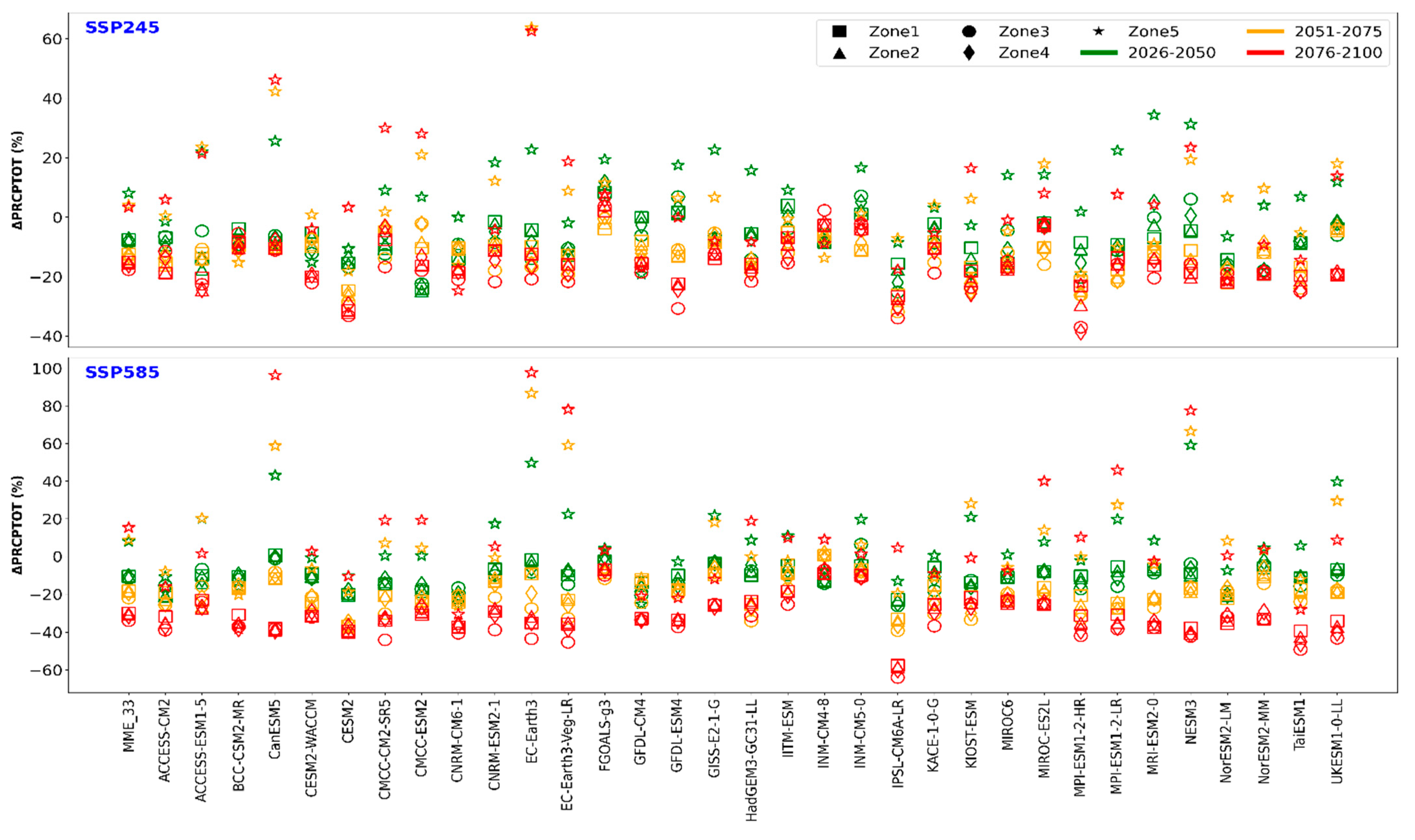
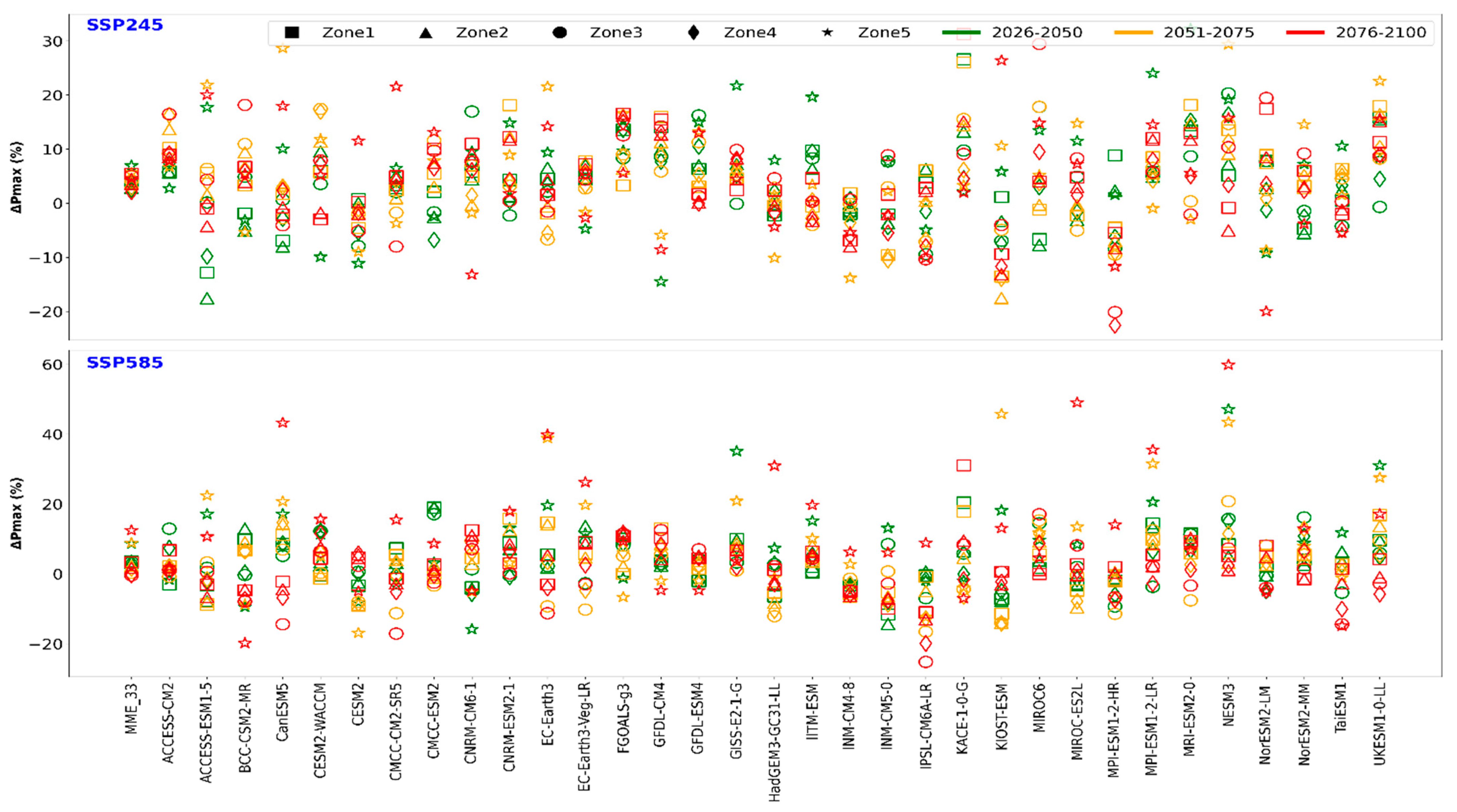




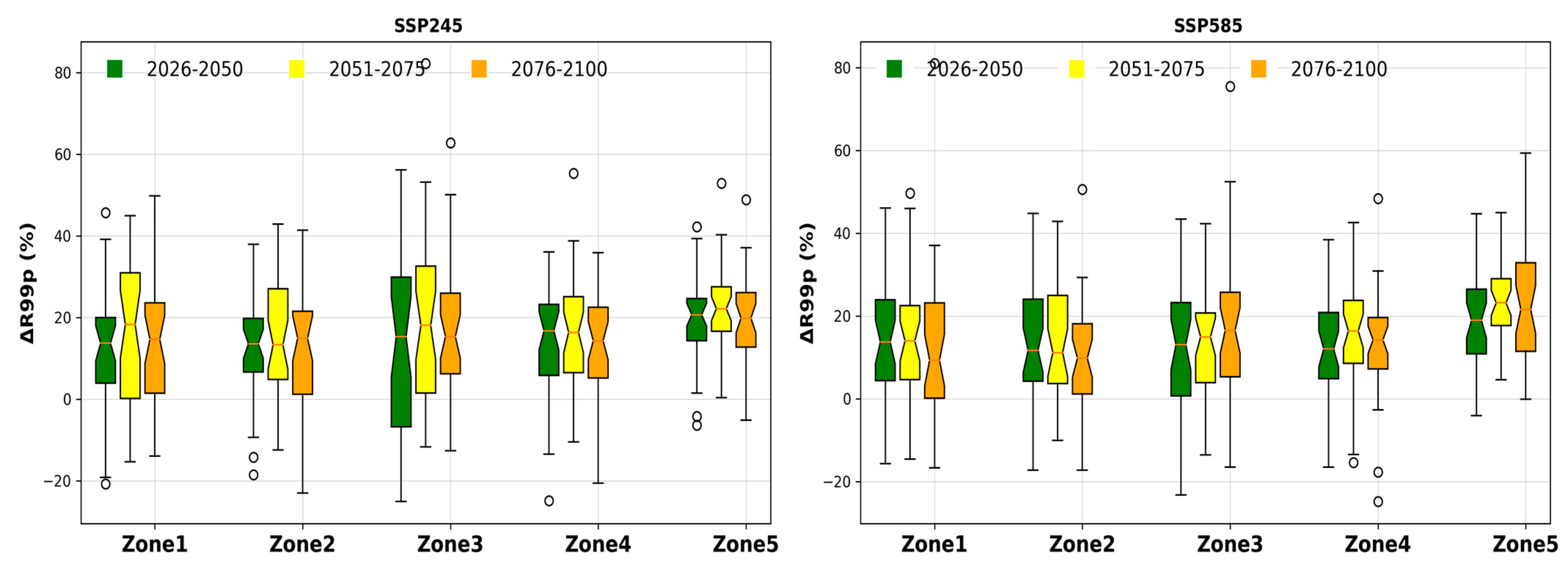


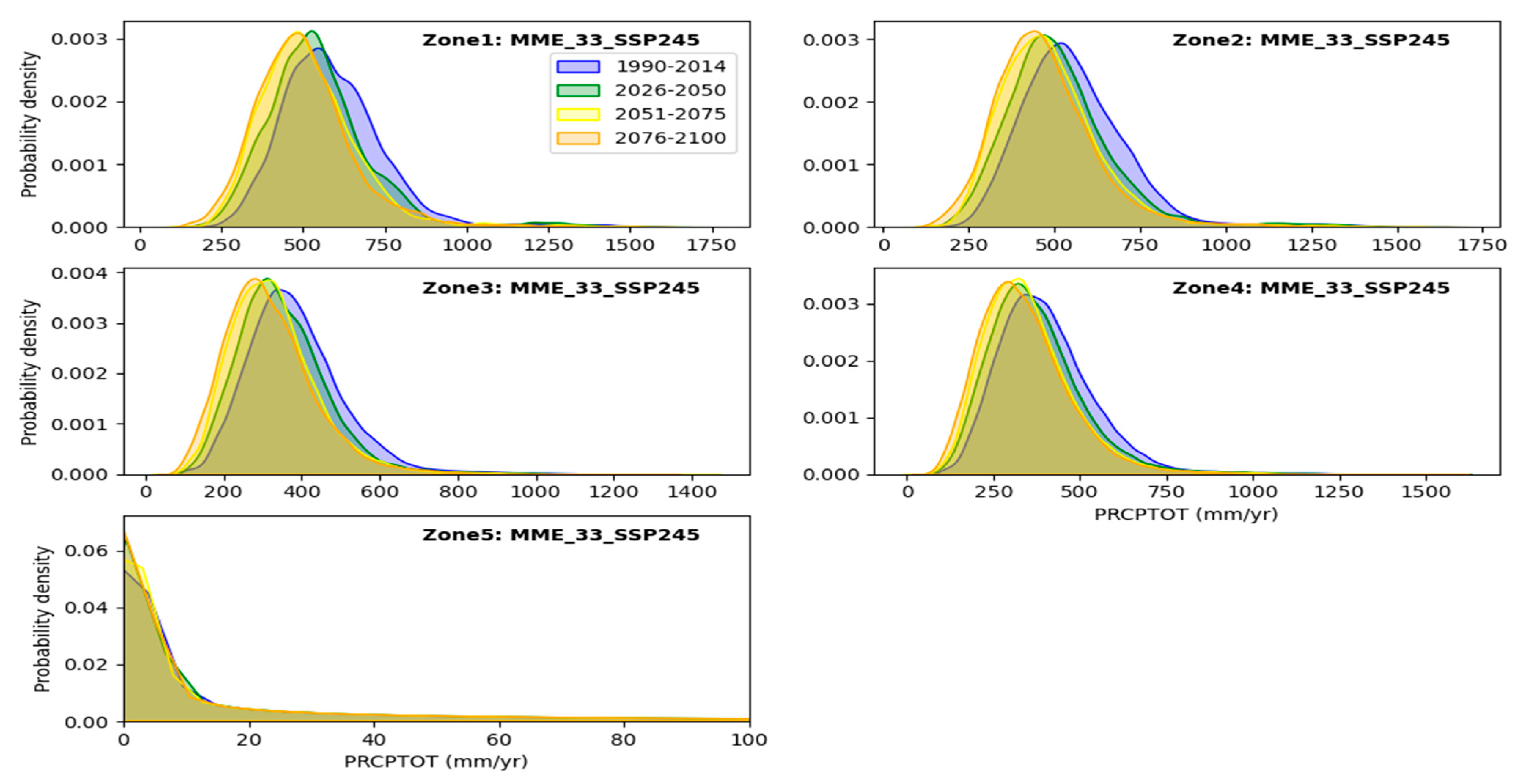
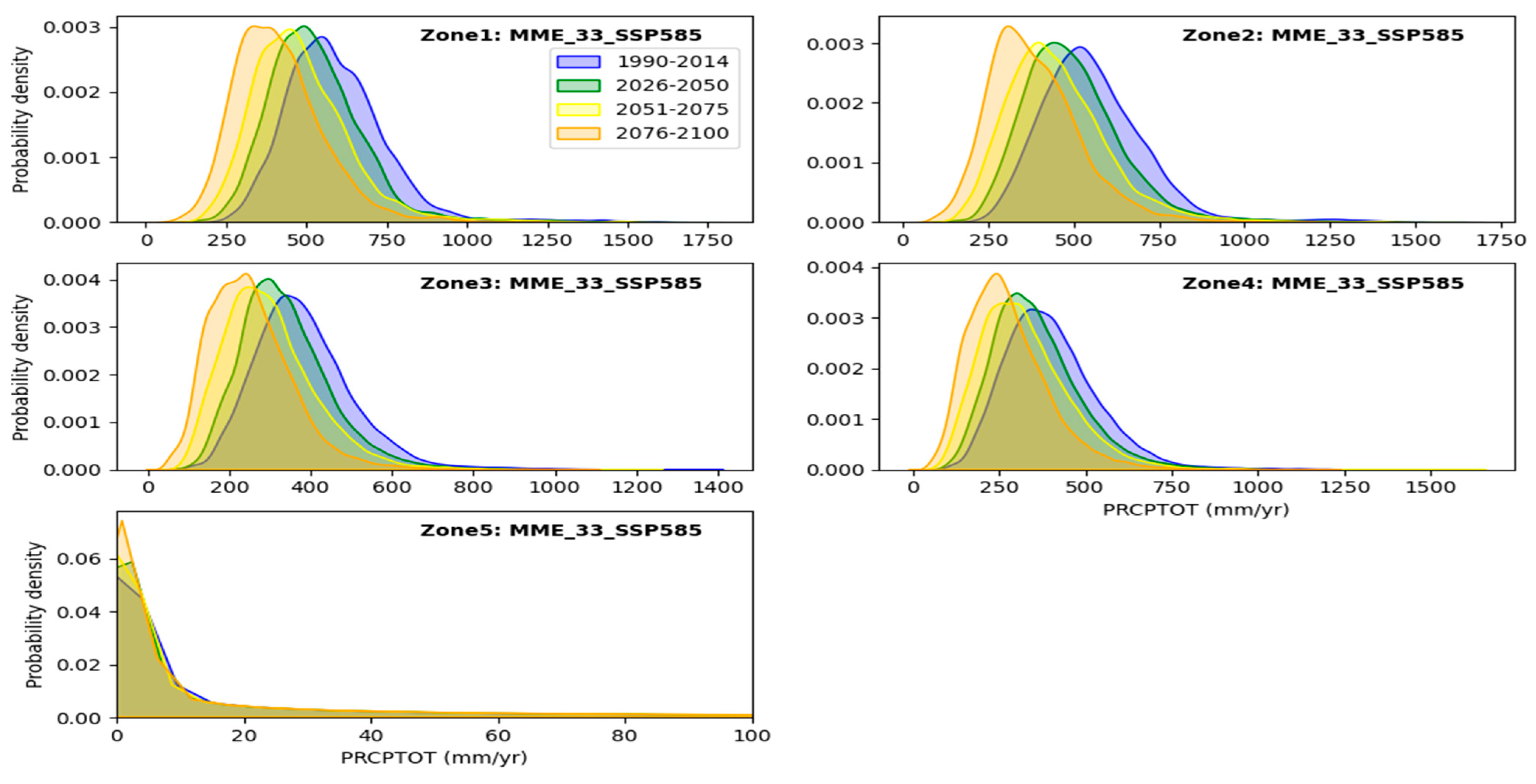
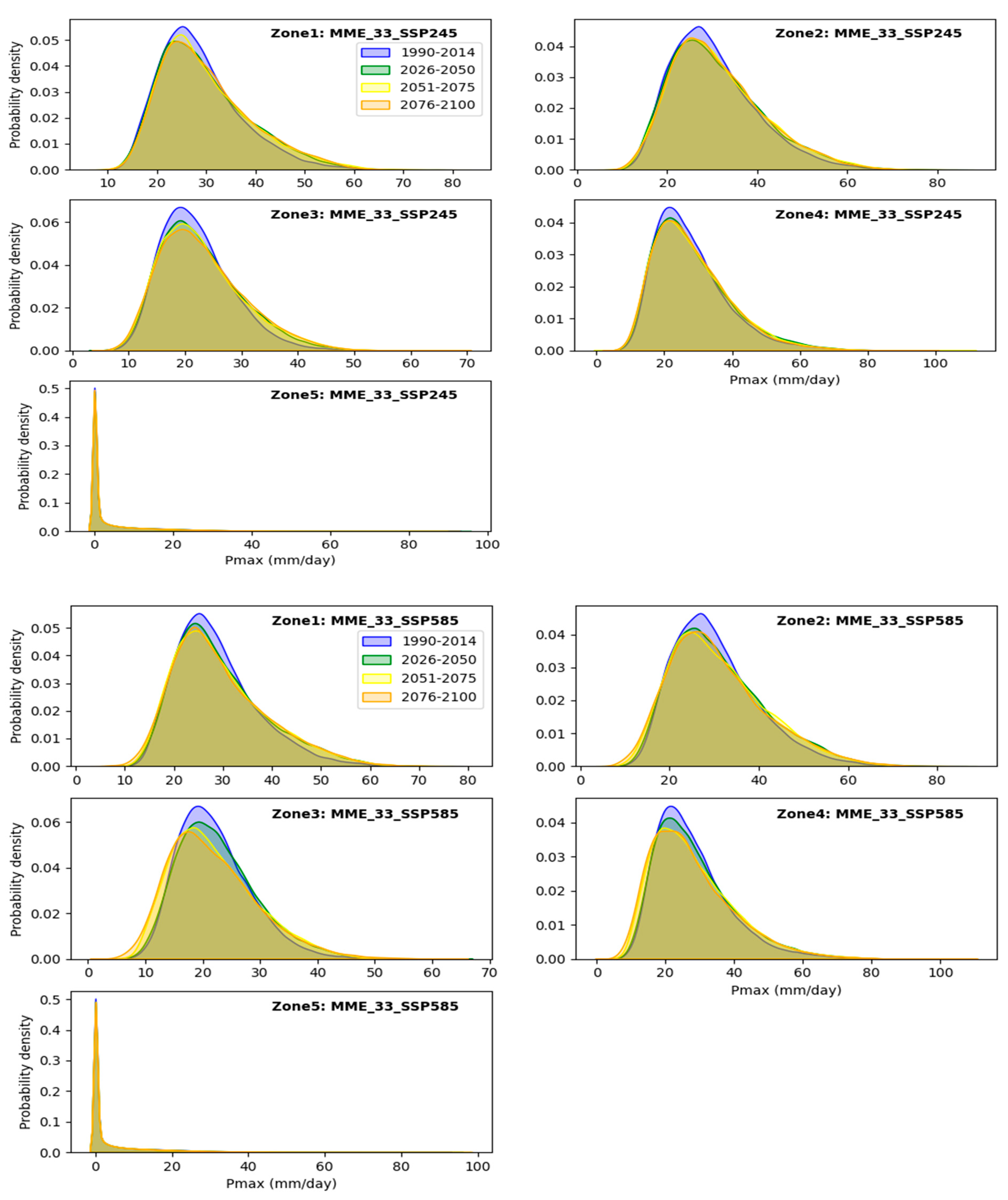

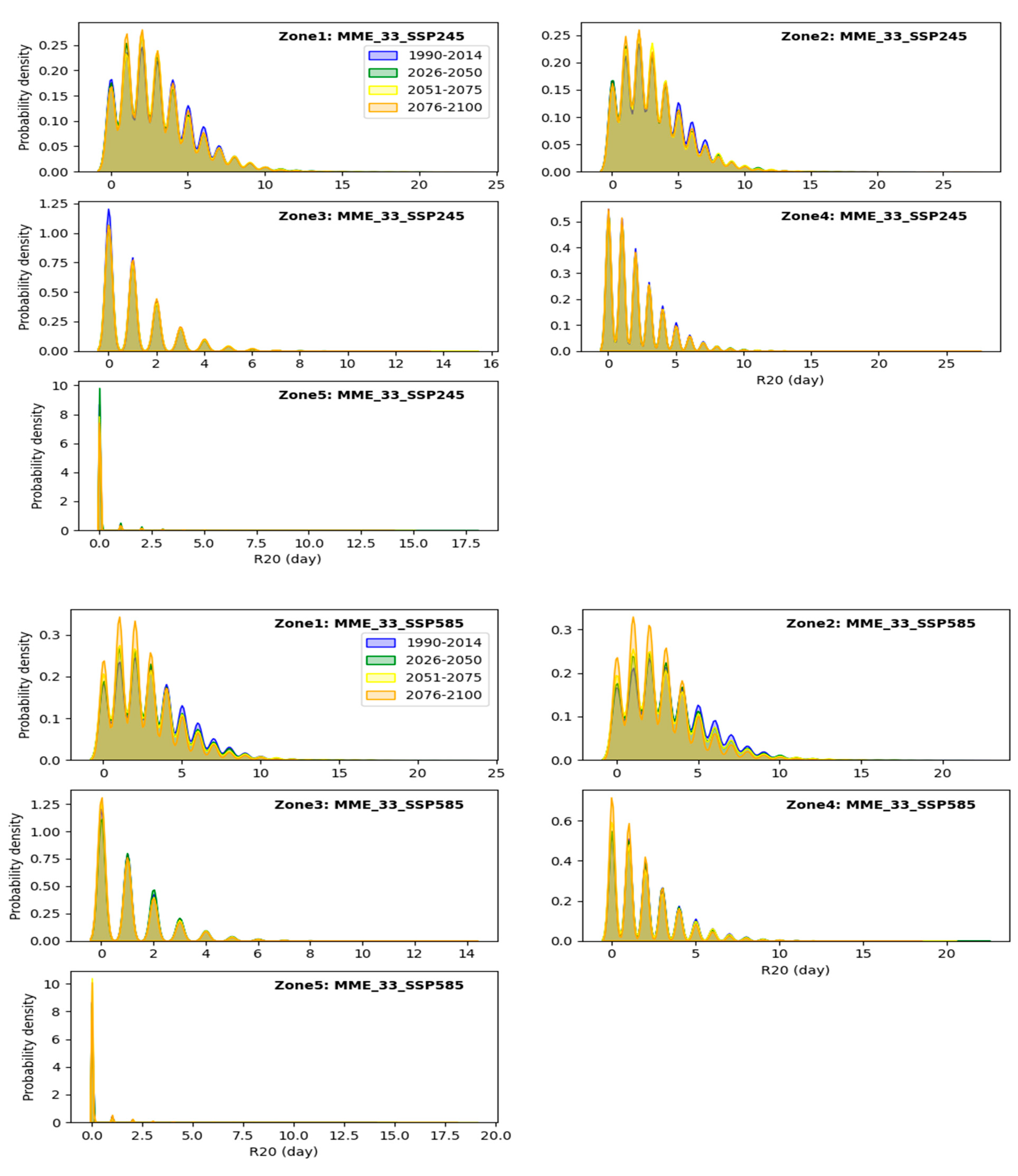
| Index | Index Name | Definition | Units | |
|---|---|---|---|---|
| 01 | PRCPTOT | Wet-day precipitation | Annual total precipitation in wet days | mm |
| 02 | RX1day or Pmax | Maximum 1-day precipitation | Annual maximum 1-day precipitation | mm |
| 03 | R99p | Extremely wet-day precipitation | Annual total precipitation from days > 99th percentile | mm |
| 04 | R20mm | Number of heavy precipitation days | Annual number of days when daily precipitation ≥ 20 mm | days |
Disclaimer/Publisher’s Note: The statements, opinions and data contained in all publications are solely those of the individual author(s) and contributor(s) and not of MDPI and/or the editor(s). MDPI and/or the editor(s) disclaim responsibility for any injury to people or property resulting from any ideas, methods, instructions or products referred to in the content. |
© 2024 by the authors. Licensee MDPI, Basel, Switzerland. This article is an open access article distributed under the terms and conditions of the Creative Commons Attribution (CC BY) license (https://creativecommons.org/licenses/by/4.0/).
Share and Cite
Hamitouche, Y.; Zeroual, A.; Meddi, M.; Assani, A.A.; Alkama, R.; Şen, Z.; Zhang, X. Projected Changes in Extreme Precipitation Patterns across Algerian Sub-Regions. Water 2024, 16, 1353. https://doi.org/10.3390/w16101353
Hamitouche Y, Zeroual A, Meddi M, Assani AA, Alkama R, Şen Z, Zhang X. Projected Changes in Extreme Precipitation Patterns across Algerian Sub-Regions. Water. 2024; 16(10):1353. https://doi.org/10.3390/w16101353
Chicago/Turabian StyleHamitouche, Yasmine, Ayoub Zeroual, Mohamed Meddi, Ali A. Assani, Ramdane Alkama, Zekâi Şen, and Xinhua Zhang. 2024. "Projected Changes in Extreme Precipitation Patterns across Algerian Sub-Regions" Water 16, no. 10: 1353. https://doi.org/10.3390/w16101353






